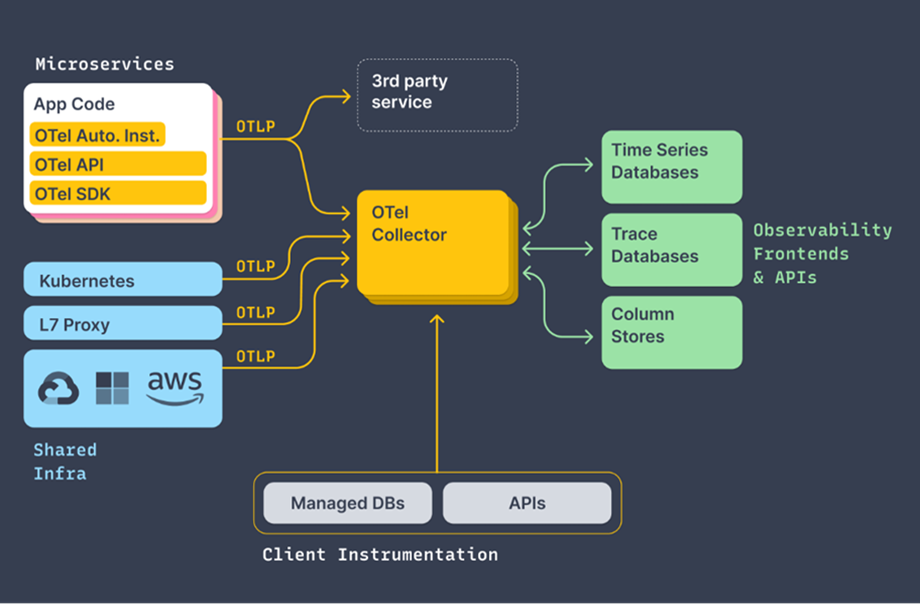Open Telemetry is an open-source project that serves as a unified observability framework for cloud-native software. It offers a comprehensive set of APIs, libraries, agents, and instrumentation that efficiently capture traces, metrics, and logs from applications and send them to backend observability platforms. This makes it easier for developers to monitor and troubleshoot their software systems effectively.
Why Open Telemetry?
Observability is crucial for modern software development, especially in cloud-native and microservice architectures. Open Telemetry plays a pivotal role in monitoring, tracing, and debugging applications. For .NET developers, Open Telemetry offers specific libraries and integrations that allow seamless tracing of requests across .NET services, capturing essential metrics, and integration with .NET’s logging facilities.
One of the key advantages of Open Telemetry is its vendor-neutral nature. It allows you to send data to various backends like Jaeger, Zipkin, or Prometheus without changing your code. This makes it a versatile tool for developers working with different systems.
Moreover, Open Telemetry is language and framework neutral, making it a flexible solution for diverse software ecosystems. However, it does offer specific benefits for .NET developers due to the many available instrumentation libraries (e.g., ASP.NET). Instrumentation of an existing app can be done with just a few lines of startup code.
Benefits of Open Telemetry
Open Telemetry provides improved observability by giving developers and operations teams real-time insights into how their .NET applications are running. It aids efficient debugging by providing detailed traces that offer a granular view of where failures occur. Moreover, it streamlines monitoring by offering a holistic view of your application’s performance.
Three Pillars of Observability
Traces
Traces provide a detailed representation of a request’s journey through various services and components of an application. Open Telemetry allows for automatic and manual instrumentation, ensuring that even the most complex transactions can be visualized.
Metrics
Metrics refer to numerical data that represents a particular aspect of a system’s state at a given point in time. Open Telemetry provides tools and libraries to capture, aggregate, and export these metrics from .NET applications to observability platforms.
Logs
Logs are textual or binary data emitted by applications, often containing information about events, transactions, or errors. Integrating Open Telemetry can enhance traditional logging by providing context from traces or metrics.

Open Telemetry Unified Data Model
Open Telemetry offers more than just individual observability signals; it’s designed to present these signals in a unified manner. This integration allows for a comprehensive and interconnected view of telemetry data, providing richer insights and faster debugging.
Benefits for .NET Developers
For developers working with .NET, this unified approach simplifies observability. It leads to cleaner code and reduces technical debt due to simplified instrumentation. It ensures consistent context across all your observability data. And it provides richer insights by having a cohesive view.
Microsoft’s Embrace of Open Telemetry
Microsoft is excited to embrace Open Telemetry as the future of telemetry instrumentation. They see it as providing “consistent APIs/SDKs across languages” for Azure Monitor Application Insights users when monitoring their applications’ performance.
Limitations
Open Telemetry is still maturing. As with any evolving project, there are areas where it could be more robust. For instance, integrating existing systems and applications could be smoother. Integrating Open Telemetry into a complex system might require significant effort and technical understanding.
Moreover, while Open Telemetry aims to provide a unified solution for traces, metrics, and logs, the support for these pillars of observability is not yet evenly mature. Tracing is the most mature aspect of Open Telemetry, while metrics and logs are still under active development.
The Future of Open Telemetry
Despite these challenges, the future of Open Telemetry looks promising. The community behind Open Telemetry is actively improving its features and smoothing its rough edges. As the project matures, we expect more streamlined integration processes and robust support for metrics and logs.
In conclusion, while Open Telemetry is an exciting development in observability, potential adopters should be aware of its current limitations and actively follow its progress.






